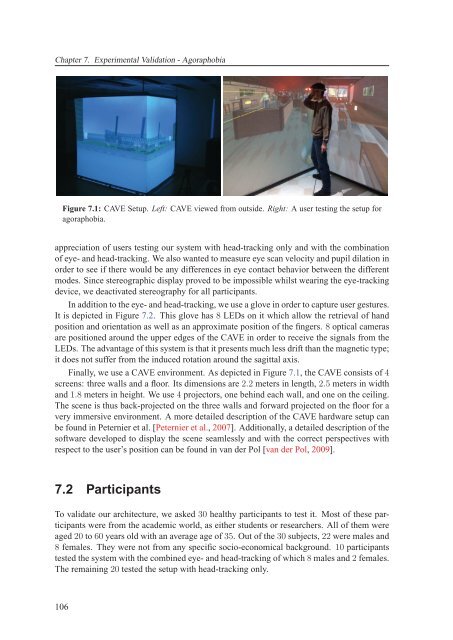Texte intégral / Full text (pdf, 20 MiB) - Infoscience - EPFL
Texte intégral / Full text (pdf, 20 MiB) - Infoscience - EPFL
Texte intégral / Full text (pdf, 20 MiB) - Infoscience - EPFL
Create successful ePaper yourself
Turn your PDF publications into a flip-book with our unique Google optimized e-Paper software.
Chapter 7. Experimental Validation - Agoraphobia<br />
Figure 7.1: CAVE Setup. Left: CAVE viewed from outside. Right: A user testing the setup for<br />
agoraphobia.<br />
appreciation of users testing our system with head-tracking only and with the combination<br />
of eye- and head-tracking. We also wanted to measure eye scan velocity and pupil dilation in<br />
order to see if there would be any differences in eye contact behavior between the different<br />
modes. Since stereographic display proved to be impossible whilst wearing the eye-tracking<br />
device, we deactivated stereography for all participants.<br />
In addition to the eye- and head-tracking, we use a glove in order to capture user gestures.<br />
It is depicted in Figure 7.2. This glove has 8 LEDs on it which allow the retrieval of hand<br />
position and orientation as well as an approximate position of the fingers. 8 optical cameras<br />
are positioned around the upper edges of the CAVE in order to receive the signals from the<br />
LEDs. The advantage of this system is that it presents much less drift than the magnetic type;<br />
it does not suffer from the induced rotation around the sagittal axis.<br />
Finally, we use a CAVE environment. As depicted in Figure 7.1, the CAVE consists of 4<br />
screens: three walls and a floor. Its dimensions are 2.2 meters in length, 2.5 meters in width<br />
and 1.8 meters in height. We use 4 projectors, one behind each wall, and one on the ceiling.<br />
The scene is thus back-projected on the three walls and forward projected on the floor for a<br />
very immersive environment. A more detailed description of the CAVE hardware setup can<br />
be found in Peternier et al. [Peternier et al., <strong>20</strong>07]. Additionally, a detailed description of the<br />
software developed to display the scene seamlessly and with the correct perspectives with<br />
respect to the user’s position can be found in van der Pol [van der Pol, <strong>20</strong>09].<br />
7.2 Participants<br />
To validate our architecture, we asked 30 healthy participants to test it. Most of these participants<br />
were from the academic world, as either students or researchers. All of them were<br />
aged <strong>20</strong> to 60 years old with an average age of 35. Out of the 30 subjects, 22 were males and<br />
8 females. They were not from any specific socio-economical background. 10 participants<br />
tested the system with the combined eye- and head-tracking of which 8 males and 2 females.<br />
The remaining <strong>20</strong> tested the setup with head-tracking only.<br />
106

















